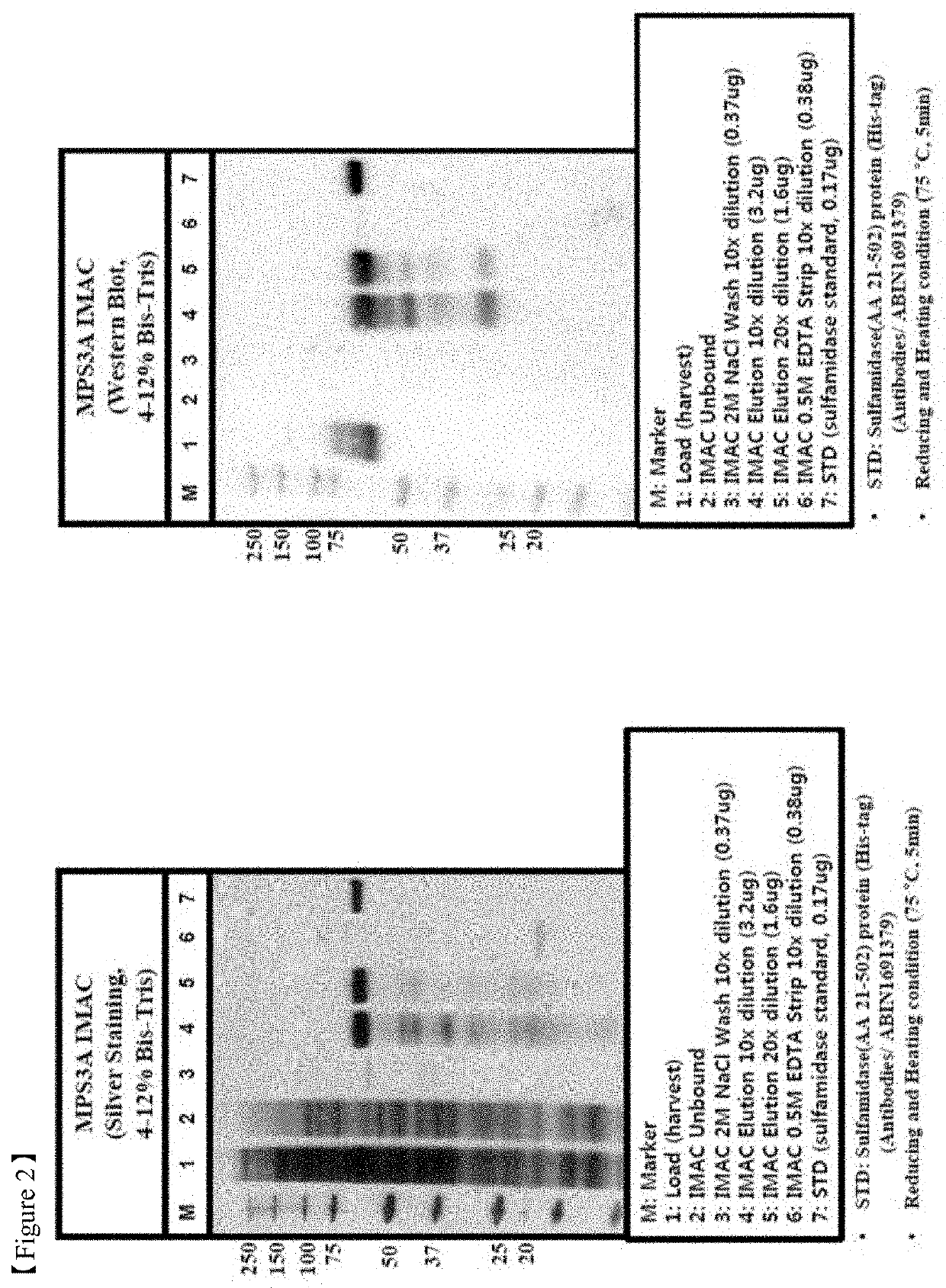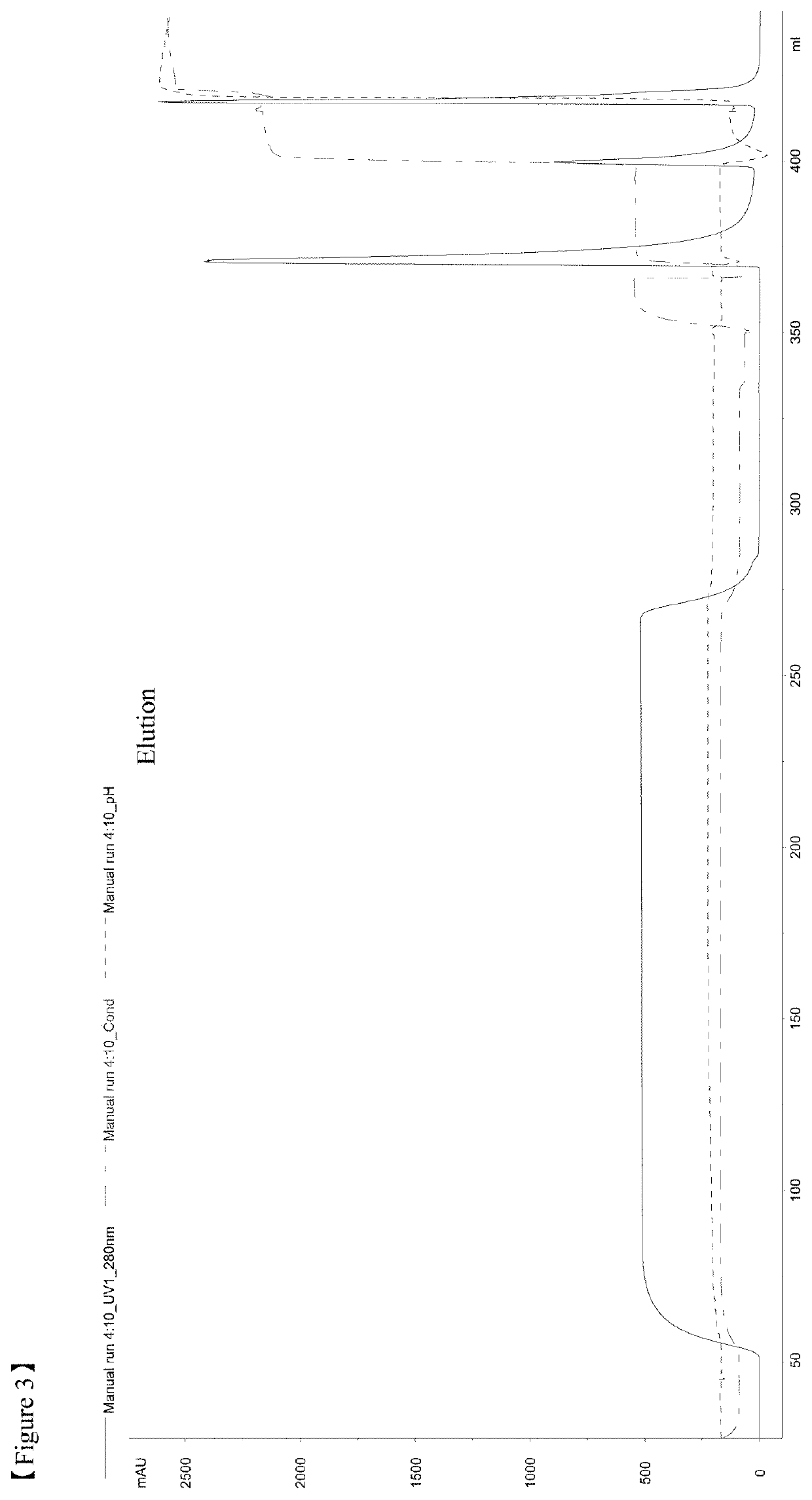Method for purifying a sulfatase protein
a sulfatase and protein technology, applied in the field of purification of sulfatase proteins, can solve the problems of mps iiia individuals with a marked developmental delay, deficiency or absence of this enzyme, and shorten the time required for purification, so as to reduce the cost of membrane filters and reduce the volume of buffers. , the effect of shortening the purification tim
- Summary
- Abstract
- Description
- Claims
- Application Information
AI Technical Summary
Benefits of technology
Problems solved by technology
Method used
Image
Examples
example 1
[0106]All the chromatography steps were performed at the room temperatures. FIG. 11 shows the flow chart of a purification method according to the example 1. Chromatography equipment: Akta Explorer, or Akta Purifier 100, or Akta Pilot by GE Healthcare.
[0107]5 M NaCl added to clarified harvest to NaCl concentration 0.5M. pH was adjusted to 7.2-7.6 by adding 1 M Tris.
[0108]Column packed with IMAC Sepharose (column volumes 5 ml, 30 or 200 ml, column types HiTrap or XK16 or XK50 from GE Healthcare) was washed by distilled water (2CV), buffer A—20-50 mM Tris-HCl, 0.5 M NaCl, pH 7.4-7.5—(2CV), distilled water (1.5CV), then charged with Zn2+ by passing 0.1-0.2 M ZnCl2 (1CV), followed by distilled water (1.5CV) and equilibrated by buffer A (2CV).
[0109]Harvest prepared as described above was loaded to equilibrated IMAC column with the flow rate 50-150 cm / h, washed by buffers A (5CV), B—20-50 mM Tris-HCl, 1-2 M NaCl, pH 7.4-7.5 (10CV), C—20-50 mM NaOAc, 100 mM NaCl, 0-10% i-PrOH, pH 6.4 (10CV...
example 2
[0129]All the chromatography steps were performed at the room temperatures. FIG. 13 shows the flow chart of a purification method according to the example 2. Chromatography equipment: Akta Explorer, or Akta Purifier 100, or Akta Pilot by GE Healthcare.
[0130]5 M NaCl added to clarified harvest to NaCl concentration 0.5M. pH was adjusted to 7.2-7.6 by adding 1 M Tris.
[0131]Column packed with IMAC Sepharose (column volumes 5 ml, 30 or 200 ml, column types HiTrap or XK16 or XK50 from GE Healthcare) was washed by distilled water (2CV), buffer A—20-50 mM Tris-HCl, 0.5 M NaCl, pH 7.4-7.5 - (2CV), distilled water (1.5CV), then charged with Zn2+ by passing 0.1-0.2 M ZnCl2 (1CV), followed by distilled water (1.5CV) and equilibrated by buffer A (2CV).
[0132]Harvest prepared as described above was loaded to equilibrated IMAC column with the flow rate 50-150 cm / h, washed by buffers A (5CV), B—20-50 mM Tris-HCl, 1-2 M NaCl, pH 7.4-7.5 (10CV), C—20-50 mM NaOAc, 100 mM NaCl, 0-10% i-PrOH, pH 6.4 (10...
example 3
[0147]All the chromatography steps were performed at the room temperatures. FIG. 15 shows the flow chart of a purification method according to the example 3. Chromatography equipment: Akta Explorer, or Akta Purifier 100, or Akta Pilot by GE Healthcare.
[0148]5 M NaCl added to clarified harvest to NaCl concentration 0.5M. pH was adjusted to 7.2-7.6 by adding 1 M Tris.
[0149]Column packed with IMAC Sepharose (column volumes 5 ml, 30 or 200 ml, column types HiTrap or XK16 or XK50 from GE Healthcare) was washed by distilled water (2CV), buffer A—20-50 mM Tris-HCl, 0.5 M NaCl, pH 7.4-7.5 - (2CV), distilled water (1.5CV), then charged with Zn2+ by passing 0.1-0.2 M ZnCl2 (1CV), followed by distilled water (1.5CV) and equilibrated by buffer A (2CV).
[0150]Harvest prepared as described above was loaded to equilibrated IMAC column with the flow rate 50-150 cm / h, washed by buffers A (5CV), B—20-50 mM Tris-HCl, 1-2 M NaCl, pH 7.4-7.5 (10CV), C—20-50 mM NaOAc, 100 mM NaCl, 0-10% i-PrOH, pH 6.4 (10...
PUM
| Property | Measurement | Unit |
|---|---|---|
| conductivity | aaaaa | aaaaa |
| conductivity | aaaaa | aaaaa |
| conductivity | aaaaa | aaaaa |
Abstract
Description
Claims
Application Information
 Login to View More
Login to View More - R&D
- Intellectual Property
- Life Sciences
- Materials
- Tech Scout
- Unparalleled Data Quality
- Higher Quality Content
- 60% Fewer Hallucinations
Browse by: Latest US Patents, China's latest patents, Technical Efficacy Thesaurus, Application Domain, Technology Topic, Popular Technical Reports.
© 2025 PatSnap. All rights reserved.Legal|Privacy policy|Modern Slavery Act Transparency Statement|Sitemap|About US| Contact US: help@patsnap.com



